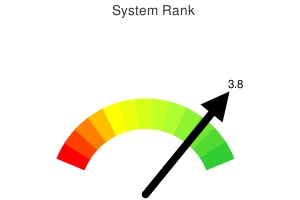System Ranking Tool
The System Ranking Tool generates a relative rank for a trading system based on prior trading history. The ranking can be used to compare the relative strength of systems and, as a forecasting tool, the rankings can be used to predict future performance.
The composition and ideas behind the System Ranking can be found in this paper. Here however, the largest losing trade is dropped from the calculation so the results won't be skewed by varying margin and capital requirements between systems trading in different markets.
The ranking can be used by system developers to compare individual trading systems within a market and when developing for new markets where the system parameters are new and a familiar baseline will speed development. System traders can use the tool to monitor the ebb and flow of their systems and gain insight into future performance and potential trouble spots. System purchasers can use the tool to evaluate systems prior to purchase. The ranking can also be used to rank and predict the future performance of discretionary traders.
As a baseline, on 12/31/2008 our S&P Strategy had a rank of 3.8 based on trades since 1997.

Worse Better
Systems with ranks below 0.5 are suspect and should be examined and retested.
Enter the seven statistics needed to generate the Ranking and then press "Universal System Ranking..."